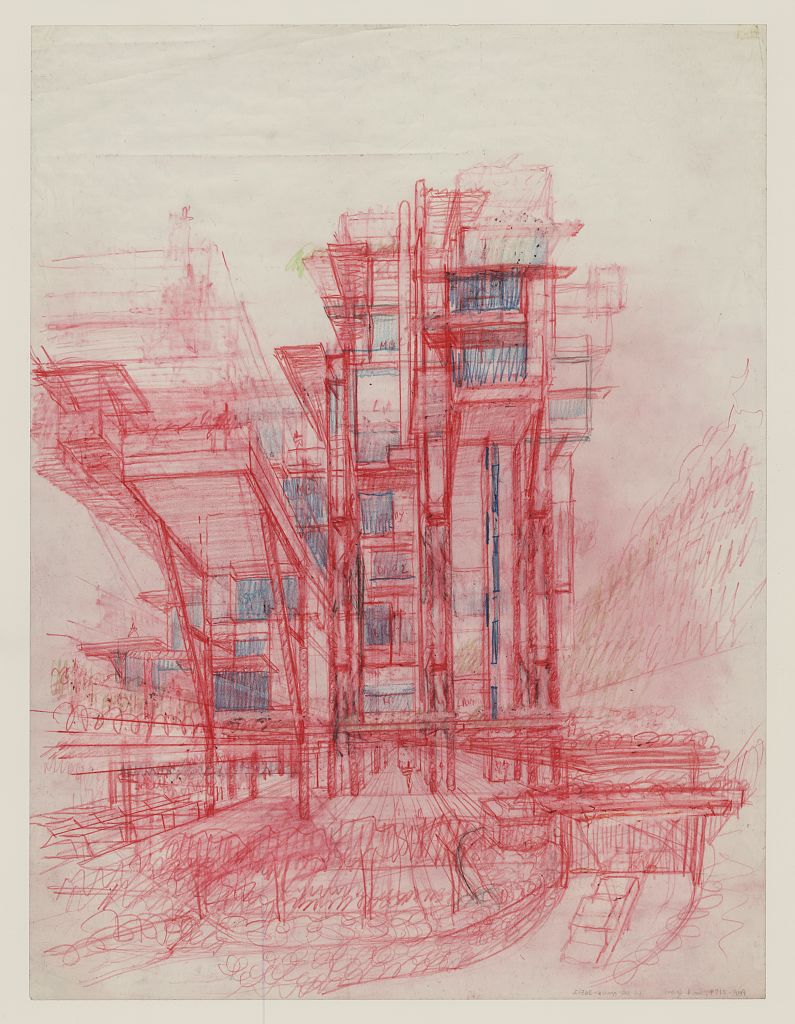Welcome to the Archives of The Paul Rudolph Institute for Modern Architecture. The purpose of this online collection is to function as a tool for scholars, students, architects, preservationists, journalists and other interested parties. The archive consists of photographs, slides, articles and publications from Rudolph’s lifetime; physical drawings and models; personal photos and memorabilia; and contemporary photographs and articles.
Some of the materials are in the public domain, some are offered under Creative Commons, and some are owned by others, including the Paul Rudolph Estate. Please speak with a representative of The Paul Rudolph Institute for Modern Architecture before using any drawings or photos in the Archives. In all cases, the researcher shall determine how to appropriately publish or otherwise distribute the materials found in this collection, while maintaining appropriate protection of the applicable intellectual property rights.
In his will, Paul Rudolph gave his Architectural Archives (including drawings, plans, renderings, blueprints, models and other materials prepared in connection with his professional practice of architecture) to the Library of Congress Trust Fund following his death in 1997. A Stipulation of Settlement, signed on June 6, 2001 between the Paul Rudolph Estate and the Library of Congress Trust Fund, resulted in the transfer of those items to the Library of Congress among the Architectural Archives, that the Library of Congress determined suitable for its collections. The intellectual property rights of items transferred to the Library of Congress are in the public domain. The usage of the Paul M. Rudolph Archive at the Library of Congress and any intellectual property rights are governed by the Library of Congress Rights and Permissions.
However, the Library of Congress has not received the entirety of the Paul Rudolph architectural works, and therefore ownership and intellectual property rights of any materials that were not selected by the Library of Congress may not be in the public domain and may belong to the Paul Rudolph Estate.

LOCATION
Address: 57 Plantation Road
City: Hong Kong
State:
Zip Code:
Nation: China
STATUS
Type: Housing
Status: Project
TECHNICAL DATA
Date(s): 1994
Site Area:
Floor Area:
Height:
Floors (Above Ground):
Building Cost:
PROFESSIONAL TEAM
Client: Wee Ee Chao
Architect: Paul Rudolph
Rudolph Staff: Mark Squeo, Job Captain (1990-1991)
Associate Architect:
Landscape:
Structural:
MEP:
QS/PM:
SUPPLIERS
Contractor:
Subcontractor(s):
Wee Duplex
Designed for a hill-top site with beautiful views, this would have been a triplex of luxury apartments, surmounted by a penthouse whose use was to be shared by the apartments’ residents. To circumvent the proscribed limits on footprint square-footage, Rudolph raised most of the building above the ground (including the apartments’ swimming pools.)
The composition needed to be compact, owing to the confined size of its site. It is densest at the building’s center: the functional core where are located elevators and exit stairs (almost the only elements, other than structure, which reach all-the-way to the ground.) Around them, the apartments’ living spaces spiral--and project outward in all directions.
To achieve this arrangement, the dwellings are interwoven through a complex of structural elements: concrete columns, cantilevered & suspended slabs & beams, and prominent diagonal struts. Every apartment would have had at least two floors—and some of Rudolph’s drawings indicate that he considered an even more complex arrangement of levels. As Rudolph’s career progressed, his renderings would increasingly include built-in plantings, showing that they were ever more prominent in his thinking. In this project (and softening the structural expression) are plants that thread through the architecture.
The 12,000 sq. ft structure sits high above the ground on pilotis with shifting cantilevered planes which make the building look like a giant kite.
The frame of the structure is made of concrete covered in reflective aluminium and glass walls enfold the building, separating interior and exterior spaces.
Each unit has its own courtyard, elevator and terrace garden, positioned in three directions.
It remains unbuilt.
.
DRAWINGS - Design Drawings / Renderings
DRAWINGS - Construction Drawings
DRAWINGS - Shop Drawings
PHOTOS - Project Model
PHOTOS - During Construction
PHOTOS - Completed Project
PHOTOS - Current Conditions
LINKS FOR MORE INFORMATION
RELATED DOWNLOADS
PROJECT BIBLIOGRAPHY
de Alba, Roberto. (2003). Paul Rudolph: The Late Work. New York, NY: Princeton Architectural Press.






























































































































